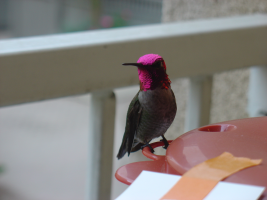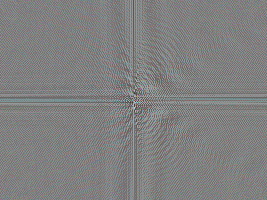One concept that can help is the Fourier transform. The Fourier transform can be used to eliminate the vertical and horizontal alignment components from the analysis. Thus we should be able to determine certain parameters, such as scale and rotation, without having to first solve the vertical and horizontal alignment problem.
The GIMP image tool has a plug-in that permits computation of the Fourier transform of an image. (Presumably Photoshop has a similar tool).

The unmodified left-eye view from yesterday
 Fourier transform of the same bird image, as generated by the GIMP plug in.
Fourier transform of the same bird image, as generated by the GIMP plug in.Believe it or not, the Fourier transform contains all of the information necessary to reconstruct the original image.
It is difficult for the human eye to make sense of the Fourier transform image. The two largest features are a big vertical stripe down the middle, and a horizontal stripe across the center. Unfortunately, these features are a BAD thing. They show that the Fourier transform is dominated by something I don't care about.
What features of the original image have strong horizontal and vertical components, causing the primary features of the Fourier transform? This is perhaps a subtle point: the edges of the image cause these features. This is a problem. If we want to use the Fourier transform to detect the relative rotation between two images, we cannot have the edges of the image dominating the Fourier transform. The vertical and horizontal edges of the images will be used to form the rotational alignment, and no rotation will occur.
The solution is to remove the edges of the image before taking the Fourier transform. But how do you remove the edges of an image? Like this:
I created a circular mask for the imtage, so that it would be radially symmetric, thus minimizing image shape artifacts in lining up the relative rotation of two images. Further, I made the mask a blurry circle, figuring that a blurry edge would have more localized effects on only the low-resolution region of the Fourier transform. The new Fourier transform of the "edge-removed" version of the bird is much smoother:
It now becomes clear that many of the other primary features of that initial Fourier transform were also "ringing" artifacts related to the edge effect. To sum up the results so far:
- The Fourier transform looks like it might theoretically be a useful tool for determining the scale and/or rotation relationship between two images, without needing to first determine the translational components.
- If we end up using the Fourier transform in this way, we should include a pre-processing step in which we make a blurry-edged circular version of the two images to be compared.


No comments:
Post a Comment